横山大観記念館所蔵品
-
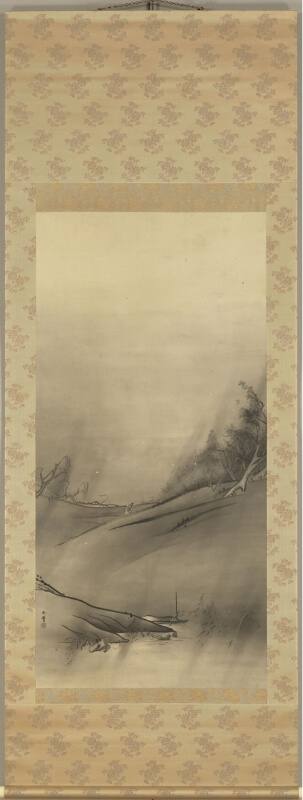
風雨
明治25年
東京美術学校在校中の制作。箱書きに自ら「処女作」としたためている。落款は「秀麿」。
Wind and Rain
1892
A piece drawn when he was a student at Tokyo Fine Arts School. In his own writing, the box inscription indicates that it is his “first work.” Signed and sealed “Hidemaro.”
-
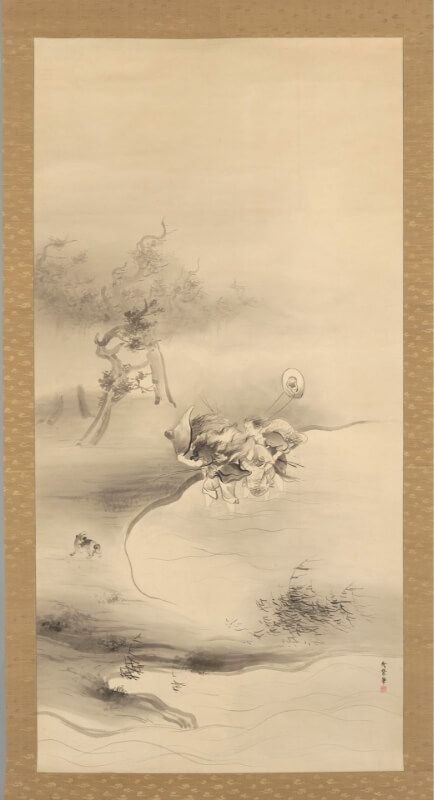
漁夫
明治28年頃
初期の制作で、毛筆の伝統的な筆づかいを残した作品。
Fishermen
c.1895
One of his early works using traditional techniques of calligraphy brushes.
-

鞴祭
明治30年頃
「ふいご」とは、空気を送り火をおこす道具。ふいご祭りは、鍛冶屋や刀工、鋳物師など、火を扱う職人たちが火の安全を祈願して行う行事。
Fuigo Matsuri (Bellows Festival)
c.1897
“Bellows” is a device for pumping air to start a fire. The “Bellows Festival” is an event held to pray for fire safety by artisans who use fire such as blacksmiths, sword makers, casters, etc.
-

月見布袋
明治33年頃
画面上に満月、画面下に月を愛でる布袋が描かれ、その間には漠然とした空間がひろがる。この漠然とした空間が観賞者に想像の余地を与えている。布袋は七福神の一人で、唐の禅僧がモデルといわれる。七福神は、福をもたらす縁起ものとして一般に親しまれている。
God of Happiness Appreciating the Full Moon
c.1900
On the upper part of this piece is a full moon and on the lower part is Hotei (God of Happiness) appreciating it. The ample space in between provides viewers to stretch their imaginations. The model of Hotei, one of the Seven Gods of Good Fortune, is said to be a Zen monk in the Tang Dynasty. The Seven Gods of Good Fortune are popular figures among the public that bring happiness and good luck.
-
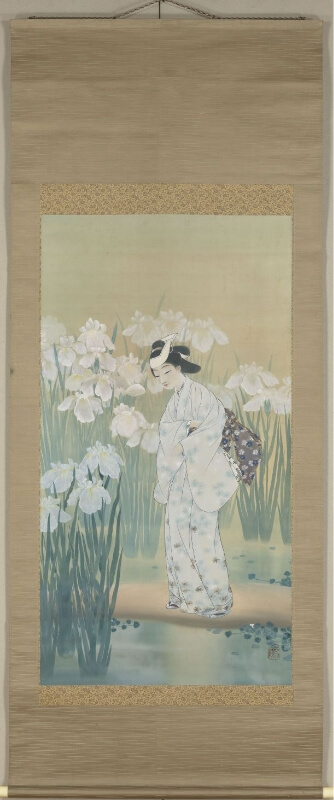
阿やめ
明治34年頃
大観には珍しい美人画の大作。古い箱書きは「水鏡」となっており、これは物の真の姿を写しだす水面を意味する言葉である。
Irises
c.1901
A large piece of a portrait of a beauty, which is an uncommon motif for Taikan. The old box inscription reads: “Suikyō”, which is a word that means a water surface that can reflect the true form of objects.
-

旭日怒涛
明治35年頃
日露戦争開戦の頃に描かれた。荒波のしぶきの向こうに高くのぼる旭日は、西洋列強のアジア進出に対する日本の姿を象徴するようである。
Rising Sun over The Rough
c.1902
A piece drawn at the time of the outbreak of the Russo-Japanese War. The rising sun that rises high beyond the splashing waves resembles Japan’s sentiment towards the Asian expansion by great Western powers.
-
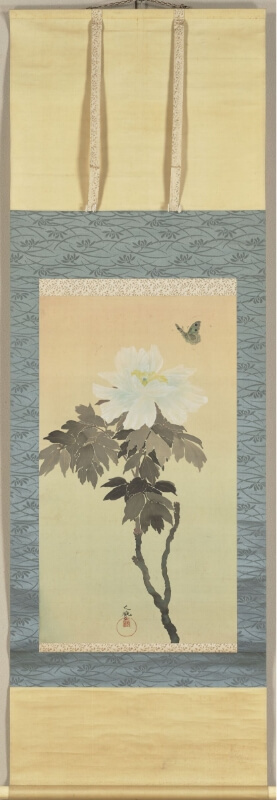
牡丹
明治37年頃
本来、余白として残されるべき背景を、淡い色で塗りつぶした。これにより幻想的なムードを演出した、「朦朧体(もうろうたい)」の代表作。
The Peony
c.1904
Taikan filled the background with a light color, which originally should have been left as a blank space. It is a representative work of the “mōrōtai technique” creating a fantastical mood.
-
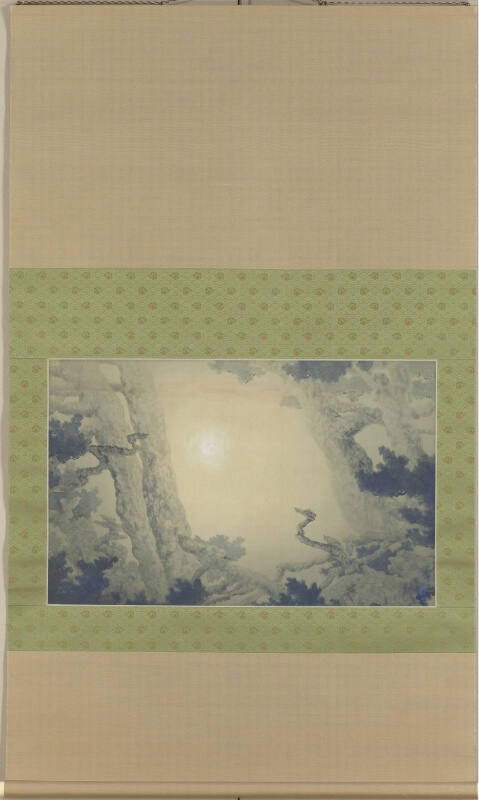
双龍争玉
明治38年
宝珠を争う二頭の龍を、月に向かってのびる松の枝に置き換えて表現している。東洋の精神と西洋の科学が日本人の心を支配する様子を表わすという、社会派的な作品。
Two Dragons Fighting for the Sacred Gem
1905
Two dragons fighting for the sacred gem is portrayed by pine branches stretching to the moon. This is a piece with a social message suggesting how the mind of the Japanese people is governed by the spirit of the East and the science of the West.
-
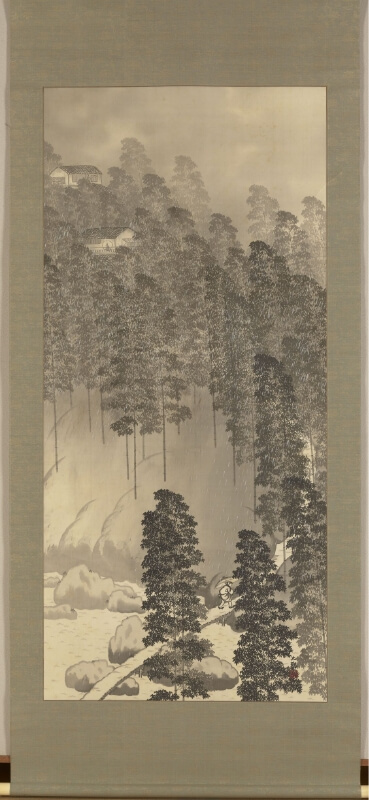
竹雨
大正4年
雨にそぼ濡れる竹林の、湿潤な空気を水墨で表現した作品。画面の下から上へと続く竹の連なりと小道が、目線を竹林の奥へといざなう。雨脚の表現に水晶末を用いるなど、画材の探求にも余念がなかった。
Bamboos in the Rain
1915
The moist air of the bamboo grove in drizzling rain is portrayed by using ink-and-wash. The bamboos drawn along the path at the bottom of the drawing naturally brings the viewers’ eyes to the top part: the heart of the grove. Taikan used crystal powder to depict the condition of the rain, which shows that he was also committed to exploring the materials he used.
-
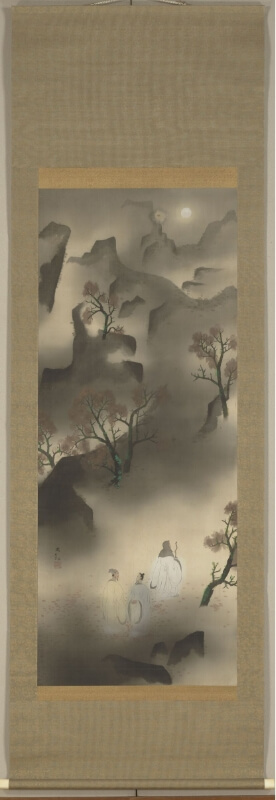
月下逍遙
大正10年頃
月明かりに照らし出された小道を高士たちがそぞろ歩く。仙境をイメージさせる幻想的な光景。途切れそうに細い線、片側に広がるぼかしなど、新しい水墨表現の技法も試みている。
Moonlight Stroll
c.1921
Virtuous men taking a stroll on a small pathway lit by moonlight. A fantastical scene suggestive of an enchanted land. In this work, Taikan is testing new ink-and-wash techniques including extremely fine lines that could break continuity, blurs that only spread on one side, etc.